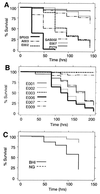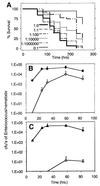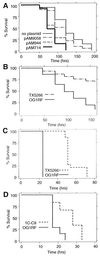A simple model host for identifying Gram-positive virulence factors
- PMID: 11535834
- PMCID: PMC58570
- DOI: 10.1073/pnas.191378698
A simple model host for identifying Gram-positive virulence factors
Abstract
We demonstrate the use of the nematode Caenorhabditis elegans as a facile and inexpensive model host for several Gram-positive human bacterial pathogens. Enterococcus faecalis, Streptococcus pneumoniae, and Staphylococcus aureus, but not Bacillus subtilis, Enterococcus faecium, or Streptococcus pyogenes, kill adult C. elegans. Focusing our studies on the enterococcal species, we found that both E. faecalis and E. faecium kill C. elegans eggs and hatchlings, although only E. faecalis kills the adults. In the case of adults, a low inoculum of E. faecalis grows to a high titer in the C. elegans intestine, resulting in a persistent infection that cannot be eradicated by prolonged feeding on E. faecium. Interestingly, a high titer of E. faecium also accumulates in the nematode gut, but does not affect the longevity of the worms. Two E. faecalis virulence-related factors that play an important role in mammalian models of infection, fsr, a putative quorum-sensing system, and cytolysin, are also important for nematode killing. We exploit the apparent parallels between Gram-positive infection in simple and more complex organisms by using the nematode to identify an E. faecalis virulence factor, ScrB, which is relevant to mammalian pathogenesis.
Figures




References
Publication types
MeSH terms
Substances
Grants and funding
LinkOut - more resources
Full Text Sources
Other Literature Sources
Molecular Biology Databases

